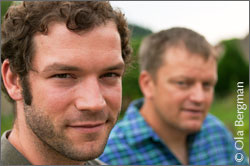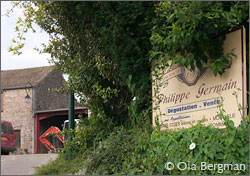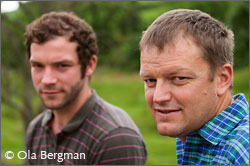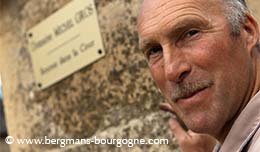
omaine Philippe Germain has its roots firmly planted up in the Hautes-Côtes. A large part of this Nantoux domaine consists of vines within the Bourgogne Hautes-Côtes de Beaune appellation.
– Our annual production of Hautes-Côtes is between 20 000 and 23 000 bottles, when nature is nice to us, explains Maxime Champaud. Out of these, 10 000 bottles are white (chardonnay), and 13 000 bottles are red (pinot noir). But when the weather is less good, like in 2010, we produce no more than a total of 12 000 bottles…

Nantoux is a small village up in the Hautes-Côtes, about four kilometres north-west of Pommard. As you leave the village towards Bouze-lès-Beaune you'll find Domaine Philippe Germain on your left. The climate is slightly cooler up here compared with the Côte d'Or down below. In years with less favourable weather conditions the Hautes-Côtes tend to suffer.
The history of the domaine goes back to the early 20th century. Maxime Champaud's great-grandfather, born in 1905, founded the domaine some time after the First World War. Then his grandfather took over in 1960.
– At this time Nantoux was a village with a population of 700 or 800 people, says Maxime Champaud. Today we are less than 200. My great-grandfather began to work at an early age in order to feed his family. When Burgundy wine became well-known he would be stopping cars down on the road asking the drivers if they were interested in buying wine. That was the start of the domaine.

Since then Domaine Germain has been growing, both by buying vineyards and planting new. Today the domaine covers a total of twelve hectares. The portfolio has grown to include a number of different appellations on the Côte de Beaune, such as Monthélie, Auxey-Duresses, Saint-Romain, Meursault, Volnay and Pommard.
– Five years ago they planted two hectares here in Nantoux, says Maxime Champaud. Now it has become difficult to find well-exposed parcels. There are many parcels that don't see the sun until nine or ten o'clock in the morning. It becomes cooler and in difficult years it is hard to make good wines.
The domaine has vines in the Hautes-Côtes ranging from very young to 90 years old. For the red Bourgogne Hautes-Côtes de Beaune this means two different cuvées - one basic and one vieilles vignes, old vines. With the former they concentrate on preserving the fruit, whereas the latter is more powerful and receives some new oak.

– We treat the vieilles vignes like a Pommard or a Volnay, says Maxime Champaud.
There is a saying in Burgundy which loosely translated means that when a Burgundian can't see his church he gets homesick. After a few years in Paris Maxime Champaud can only agree. He is a very good example of the fact that you can take the boy out of Burgundy, but you can't take Burgundy out of the boy.

– Originally I didn't know what I wanted to do, he says. I didn't own any wines, but I wanted to work with wine. My father told me I didn't have to work in the vineyards, that I could work with the commercial side of it instead. I agreed with him and went on to studies. Then I went to Paris to learn about insurance. I worked in insurance for two years, but I knew I was destined for other things. Ever since I was two or three years old I had been out in the vineyards with my grandfather or my uncle (Philippe Germain). My uncle is only twelve years older than me so he is like a big brother to me.
In 2007 he was fed up with the insurance business, left Paris and came back to Burgundy with the intention of setting up a wine shop in Beaune.
– But instead my uncle told me he needed someone to help him. Why not, I said.

The biggest change that came with Maxime Champaud's arrival at Domaine Philippe Germain was the extension of the wine portfolio. He brought some vines from his side of the family and they also began buying grapes from other growers. Corton-Charlemagne, Pernand-Vergelesses premier cru En Caradeux, Volnay premier cru Les Pitures and even Rully from the Côte Chalonnaise were some of the new wines. The new wines are sold under Maxime Champaud's name, while the old wines remain under the Domaine Philippe Germain label.
– The grapes we buy from other growers are picked by our own pickers during harvest. It is almost only during harvest that it can be a problem to be spread out geographically like we are now. The time spent in the car is time that could be spent in the vineyards picking grapes.
Squeezed in between Mersault, Volnay and Auxey-Duresses you'll find Monthélie. This is the smallest village on the Côte de Beaune, but here in Nantoux you will be presented four different Monthélie wines – straight Monthélie village in both colours, the red Monthélie La Combe d'Anay and the red premier cru Monthélie Les Champs Fulliots.
– Monthélie has two problems, says Maxime Champaud. First, it is a small appellation, very small. So there is not enough wine produced, and therefore rarely seen. Second, like in the Hautes-Côtes the soil is very mineral and red wine produced from mineral soil is not something that is everybody's taste.
© 2010 Ola Bergman














